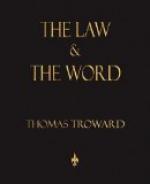That vibrations are excited by sound is beautifully exemplified by the eidophone, an instrument invented, I believe, by Mrs. Watts-Hughes, and with which I have seen that lady experiment. Dry sand is scattered on a diaphragm on which the eidophone concentrates the vibrations from music played near it. The sand, as it were, dances in time to the music, and when the music stops is found to settle into definite forms, sometimes like a tree or a flower, or else some geometrical figure, but never a confused jumble. Perhaps in this we may find the origin of the legends regarding the creative power of Orpheus’ lyre, and also the sacred dances of the ancients—who knows!
Perhaps some critical reader may object that sound travels by means of atmospheric and not etheric waves; but is he prepared to say that it cannot produce etheric waves also. The very recent discovery of transatlantic telephoning tends to show that etheric waves can be generated by sound, for on the 20th of October, 1915, words spoken in New York were immediately heard in Paris, and could therefore only have been transmitted through the ether, for sound travels through the atmosphere only at the rate of about 750 miles an hour, while the speed of impulses through ether can only be compared to that of light or 186,000 miles in a second. It is therefore a fair inference that etheric vibrations can be inaugurated by sound.
Perhaps the reader may feel inclined to say with the Irishman that all this is “as dry as ditch-water,” but he will see before long that it has a good deal to do with ourselves. For the present what I want him to realize by a few examples is the mathematical accuracy of Law. The value of these examples lies in their illustration of the fact that the Law can always be trusted to lead us on to further knowledge. We see it working under known conditions, and relying on its unchangeableness, we can then logically infer what it will do under other hypothetical conditions, and in this way many important discoveries have been made. For instance it was in this way that Mendeleef, the Russian chemist, assumed the existence of three then unknown chemical elements, now called Scandium, Gallium and Germanium. There was a gap in the orderly sequence of the chemical elements, and relying on the old maxim—“Natura nihil facit per saltum”—Nature nowhere leaves a gap to jump over—he argued that if such elements did not exist they ought to, and so he calculated what these elements ought to be like, giving their atomic weight, chemical affinities, and the like; and when they were discovered many years later they were found to answer exactly to his description. He prophesied, not by guesswork, but by knowledge of the Law; and in much the same way radium was discovered by Professor and Madame Curie. In like manner Hertz was led to the discovery of the electro-magnetic waves. The celebrated mathematician Clerk-Maxwell had calculated all particulars of these waves twenty-five




